
At times, these expressions are demystified for the audience, but occasionally Tong allows the context and acting to perform this act of translation. While audiences’ broader comprehension of the play is never affected, Singaporean and Malaysian viewers will appreciate the additional layer of rancour and humour in these sayings.
Michael Hankin’s set design is minimal, but the few props employed are a microcosm of everyday Singaporean life. The red plastic stools are common at hawker stalls. The thin dismountable mattress speaks of a very particular milieu. A koala symbolises Girl’s eagerly awaited imagined future in Australia.
Loading
At once a cautionary moral tale about the pursuit of ill-begotten riches and a portrait of a dysfunctional family loving each other in the ways they know best, Golden Blood is a story of yearning and ambition, of intergenerational trauma and breaking the cycle of abuse.
Golden Blood constantly gestures towards Chineseness through two central characters who never learned how to be Chinese, just as it portrays them trying to be a family despite their being deprived of anything close to a healthy childhood. In this way, it dances in the chasm between desire and reality.
Reviewed by Sonia Nair
CLASSICAL
Nobuyuki Tsujii ★★★★★
Melbourne Recital Centre, October 30

Pianist Nobuyuki Tsujii Credit: Giorgia Bertazzi
Pianist Nobuyuki Tsujii’s sold-out concert at the Recital Centre on Wednesday was a remarkably joyous event. He is a slight and sometimes hunched figure at the keyboard with a magnetic presence – I cannot recall a recital of such sustained ferocity and drive.
Winner of the 2009 Van Cliburn piano competition, the musician – who has been blind since birth – offered a rich and varied program played with phenomenal virtuosity, crystalline clarity and electrifying energy.
Tsujii began with Bach’s most popular French suite, a red-blooded account emphasising rhythm and momentum, followed by three Liszt pieces: the delicate Consolations, a thrilling Concert Paraphrase on Verdi’s Rigoletto of breath-taking speed and clarity, and the Mephisto Waltz No. 1, which unbelievably actually took the virtuosity up a notch.
The second half featured three Ravel pieces and eight concert etudes by composer Nikolai Kapustin, who died in 2020. These would have been new to nearly all the audience, including me, and they were a revelation: a continuously pyrotechnic fusion of modern classical, jazz and blues – like a full sprint for 20 minutes.
Loading
Tsujii’s slightly charmless Ravel, where the fingering was often too forceful to let the music shimmer, nearly reduced this review to four stars, but he soared back to five with the Kapustin and four generous encores – including perhaps the fastest La campanella (Liszt) I’ve ever heard, plus an utterly charming take on Waltzing Matilda – and one of the most fulfilled audiences I have seen.
As he left the stage for the last time, applause still thundering, he quietly closed the piano lid to show he was finished, to gales of laughter.
Reviewed by Barney Zwartz
MUSIC
Thom Yorke | Everything ★★★★
Sidney Myer Music Bowl, October 29
Thom Yorke’s first solo show in Australia was indeed a one-man affair. It ranged over eight Radiohead albums as well as his own, on simple guitar or keys (Let Down, Fake Plastic Trees, Pyramid Song), more often in surrender to hair-raising vistas of scrambled and pounding electronics (Present Tense, All I Need, Black Swan).
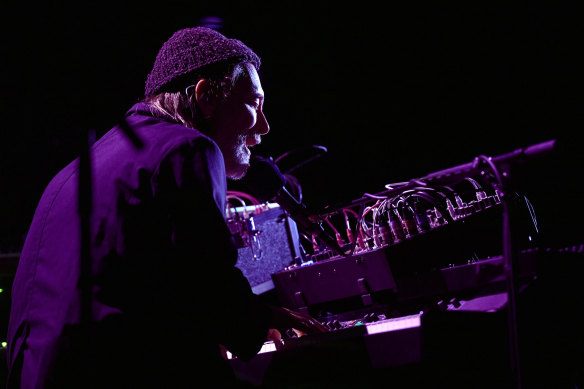
Thom Yorke performs at the Sidney Myer Music Bowl on Tuesday night.Credit: Martin Philbey
But he wasn’t the only presence on stage. The singer in the baggy black suit was surrounded by a living machine: banks of crazy-wired synths and computers and towering digital screens. He stroked its tiny keys and crooned sweetly, “Please excuse me, but I got to ask, are you only being nice because you want something?”
His face was deconstructed and blown up into a zillion pixels high above as the live video algorithm learned its contours and movements, smoothing its flaws into a hypnotic work of art. Man in harmony with technology. What could go wrong?
As he moved between knobs and wires, the inexorable handover from human to machine was a perfect reflection of his musical journey — rock songs slowly subsumed by voracious, overreaching technology — and of the central, thrilling and terrifying metaphor of his work.
The stunning live video graphics were key to the coup: dissembling his face into snowflakes and scrambling vectors, creeping animations of tiny threads swelling into suffocating cables, live action pixelated and transformed into fantastic illusions. “Time is running out for us,” Yorke sang as he danced in the storm.
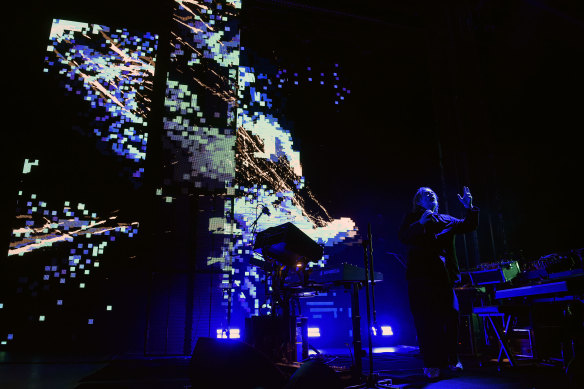
Thom Yorke’s performance was backdropped by live video graphics.Credit: Martin Philbey
There was little room for banter, but human connection and gratitude flowed both ways through the ether. A couple of small jokes were enough to keep the ghost in control of the machine.
Finally, Yorke dedicated Lucky to both his bands (though The Smile’s three albums were untouched tonight), and to his good fortune that we “still give a shit”. A quarter-century after OK Computer, its final line – “We are standing on the edge” – seemed to ring truer than ever.
Reviewed by Michael Dwyer
MUSIC
Empire of the Sun | ‘Ask That God’ Tour ★★★★
Sidney Myer Music Bowl, October 26
Attending an Empire of the Sun show in 2024 feels like both stepping back and forward in time. There’s a heady sense of nostalgia for any Millennial who came of age in the late aughts, when the duo – Luke Steele of the Perth indie band the Sleepy Jackson, and Nick Littlemore of dance trio Pnau – emerged with the catchy debut single Walking on a Dream. Some of those fans have their own kids in tow now. Yet the group’s futurism makes it feel like we’ve stepped into another world.
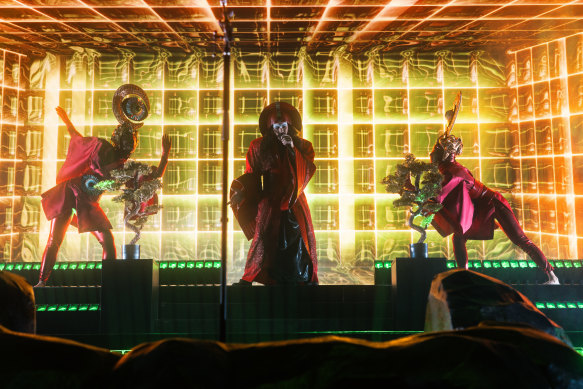
Empire of the Sun perform at the Sidney Myer Music Bowl on Saturday night.Credit: Richard Clifford
A quick note. In 2020, Littlemore apologised for the band’s early costumes and sets, which he acknowledged were culturally appropriative. Littlemore is absent from live proceedings now, but the aesthetic still borrows heavily from other cultures, particularly Japanese. The imagery – bonsai trees, dancers in geisha-style make-up, Steele as an emperor – strongly evokes old-timey visions of Asia, veering uncomfortably close to Orientalism. It’s jarring to witness in the modern age, and difficult to completely shake off despite the impressive production.
And it is an impressive production. Steele is joined by five others on stage, including two dancers, and the stage is flanked by two large, white faces, which form a kind of landscape. New elements are brought in with every song, and the costumes are especially spectacular, from full-body disco ball suits to elaborate sun and moon headpieces to the dancers transforming into trees.
It’s over the top, theatrical, and utterly spellbinding – seeing the set and costumes is worth the cost of admission alone. The production is so immersive and otherworldly that it’s genuinely strange when Steele speaks in a broad Australian accent, like being jolted out of a reverie.
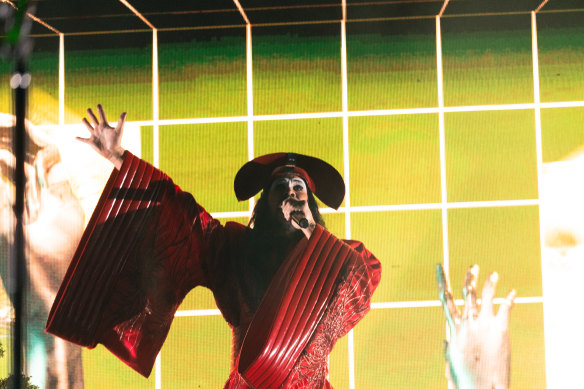
Attending an Empire of the Sun show in 2024 feels like both stepping back and forward in time.Credit: Richard Clifford
Loading
The atmosphere is electric, feeling more like an outdoor festival than a standalone show: fans are on one another’s shoulders in the standing area and bodies move as one.
Songs from Ask That God, Empire’s recently released album and first since 2016, mingle seamlessly with older cuts such as We Are the People. Steele’s falsetto is note-perfect, and he proves his chops elsewhere, too, hopping on the guitar and shredding – a reminder of his band roots.
In the warm night air, as Steele wanders into the crowd in the one-two punch of Walking on a Dream and Alive, this feels like the encapsulation of an Australian music summer: euphoria, dancing, a sea of hands up. The gripes stand, but there’s undeniable magic, too.
Reviewed by Giselle Au-Nhien Nguyen
JAZZ
Melbourne International Jazz Festival
Jazzmeia Horn ★★★★
Melbourne Recital Centre, October 25
Esperanza Spalding ★★★★
Hamer Hall, October 27
Jazzmeia Horn’s new album – released last Friday to coincide with her debut Melbourne performance – is called Messages. In concert, those messages (focused on self-acceptance, self-belief and freedom of expression) are conveyed not just through Horn’s lyrics, but the sense of absolute sincerity that informs her vocal delivery, between-song banter and ebullient stage presence.
The American vocalist’s show at Melbourne Recital Centre featured her long-time pianist Victor Gould and two Melbourne musicians (bassist Sam Anning and drummer Dave Beck, both working with Horn for the first time). The rhythm section formed an impressively tight unit for the singer to soar over, bounce across or dart around in thrillingly inventive scat solos.
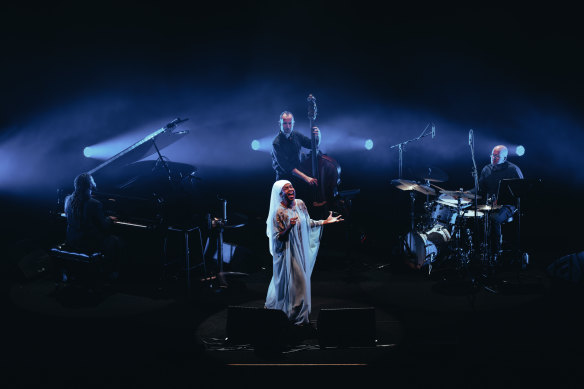
Jazzmeia Horn performs at Melbourne Recital Centre as part of the Melbourne International Jazz Festival.Credit: Duncographic
Horn’s technical mastery seemed almost limitless, but her vocal acrobatics never felt gratuitous. Rather, they were natural extensions of her in-the-moment creativity: stretching syllables into unexpected shapes, offering multiple variations on a melodic motif, or hurtling upwards to notes so high they sound more like violin harmonics.
And even in the midst of her most adventurous vocal stylings, the sentiment behind each song was never in doubt, whether Horn was urging us to answer fate’s call (Destiny), channelling wistful romantic love (Darn That Dream) or invoking the mysteries of the universe (Submit to the Unknown).
During her final number (Free Your Mind), she roamed the auditorium, radiating joy and inviting us to dance as her concert became a celebration.
Dance also formed part of Esperanza Spalding’s festival show at Hamer Hall on Sunday. On this occasion, the dance was formalised rather than spontaneous, playing an integral role in Spalding’s latest artistic endeavour.
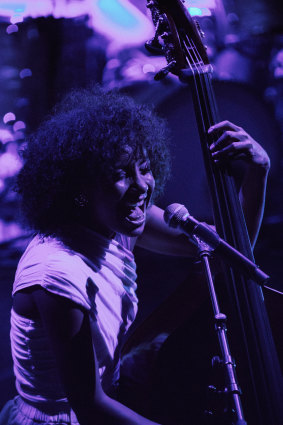
Esperanza Spalding’s voice is bell-like in its purity.Credit: Will Hamilton-Coates
When Spalding was last in Melbourne in 2016, she performed in character (as “Emily”) in a surreal performance-art piece, Emily’s D+Evolution. This time, the American bassist and vocalist was playing herself, but the originality of her approach was still on arresting display.
Her voice – bell-like in its purity and extraordinarily agile – and bass playing were as astonishing as ever, but our attention was equally drawn to the two contemporary dancers (Kaylin Horgan and Tashae Udo) creating visual extensions of the lyrics and the intent behind them.
Like Spalding’s music, the choreography was gracefully fluid at times; angular and abstract at others. Some of the most striking moments came during semi-improvised interludes between the dancers and the musicians (Spalding on bass, piano and vocals; Matt Stevens on guitar; Eric Doob on drums), when sound and movement coalesced in a mesmerising, kinetic communion.
Reviewed by Jessica Nicholas
The Booklist is a weekly newsletter for book lovers from Jason Steger. Get it every Friday.









 Add Category
Add Category